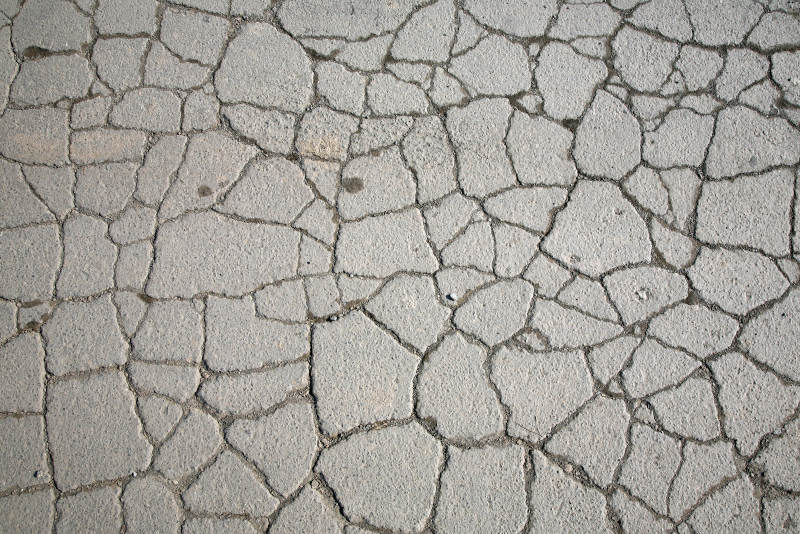Alligator cracking is a common and serious issue that affects many asphalt surfaces, from asphalt driveways to commercial paving projects. This distinctive pattern of interconnected cracks resembling an alligator’s scales can significantly compromise the integrity and longevity of asphalt pavements. At Riley’s Asphalt, we’ve encountered numerous cases of alligator cracking and understand its impact on various asphalt installations. In this post, we’ll explain the causes of alligator cracking, its potential consequences if left unaddressed, and the most effective asphalt repair methods.
What is Alligator Cracking?
Alligator cracking, also known as fatigue cracking, is characterized by a series of interconnected cracks that form a pattern similar to an alligator’s skin. These cracks typically start as longitudinal fractures and gradually evolve into a network of multi-sided angular pieces. Our team at Riley’s Asphalt recognizes that alligator cracking is more than just a surface-level issue; it often indicates underlying structural problems within the pavement.
Causes of Alligator Cracking
Several factors can contribute to the development of alligator cracking in asphalt surfaces:
- Excessive Loading: Repeated heavy traffic, especially on pavements not designed to handle such loads, can lead to fatigue and eventual cracking.
- Poor Drainage: Inadequate drainage allows water to seep into the pavement structure, weakening the base and subgrade layers.
- Insufficient Pavement Thickness: When the asphalt layer is too thin to support the applied loads, it can result in fatigue cracking.
- Weak Base or Subgrade: A poorly constructed or inadequately compacted base or subgrade fails to provide proper support for the asphalt surface.
- Age and Weathering: Over time, exposure to the elements causes the asphalt binder to oxidize and become brittle, making it more susceptible to cracking.
- Improper Construction: Faulty construction practices, such as inadequate compaction or using low-quality materials, can lead to premature cracking.
Consequences of Ignoring Alligator Cracking
Neglecting alligator cracking can lead to severe consequences for your asphalt surface:
- Accelerated Deterioration: As water penetrates the cracks, it weakens the underlying layers, leading to more extensive damage.
- Safety Hazards: The uneven surface created by alligator cracking can pose risks to pedestrians and vehicles.
- Reduced Lifespan: Untreated alligator cracking significantly shortens the lifespan of the asphalt pavement.
- Increased Repair Costs: Delaying repairs often results in more extensive and costly interventions in the future.
- Aesthetic Issues: Alligator cracking can make your property look neglected and unappealing, potentially affecting its value or your business’s image.
The Right Way to Repair Alligator Cracking
At Riley’s Asphalt, we emphasize that surface-level treatments like commercial sealcoating or simple crack filling are not effective long-term solutions for alligator cracking. These methods may temporarily improve appearance but do not address the underlying structural issues. Based on our extensive experience, the correct approach to repairing alligator cracking involves:
- Remove Damaged Asphalt: The first step is to completely remove the damaged section of asphalt. This includes not just the visibly cracked area but also a margin around it to ensure all compromised material is addressed.
- Inspect and Repair the Base: Once the asphalt is removed, the base layer must be thoroughly inspected. Any weak or damaged areas in the base should be repaired or replaced. This may involve adding new aggregate, compacting the existing material, or in some cases, complete base reconstruction.
- Address Drainage Issues: If poor drainage contributed to the problem, this is the time to implement proper drainage solutions. This might include adjusting the grade, installing drainage systems, or both.
- Lay New Asphalt: After ensuring the base is solid and well-drained, new asphalt can be laid. This should be done in appropriate layers, with each layer properly compacted.
- Proper Compaction: Adequate compaction of the new asphalt is crucial to ensure its longevity and resistance to future cracking.
- Quality Control: Throughout the process, it’s important to maintain strict quality control measures, including using high-quality materials and adhering to proper installation techniques.
It’s important to note that while some products marketed as quick fixes for alligator cracking may seem appealing, they often provide only temporary cosmetic improvements. These solutions do not address the root causes of the problem and can lead to more extensive and costly repairs in the future.
Preventing Alligator Cracking
While not all instances of alligator cracking can be prevented, our team at Riley’s Asphalt recommends several measures to reduce the risk:
- Proper Design: Ensure your asphalt pavement is designed to handle the expected traffic loads.
- Quality Construction: Use high-quality materials and proper construction techniques during installation.
- Regular Maintenance: Implement a routine maintenance schedule, including regular inspections and timely repairs of minor issues.
- Effective Drainage: Ensure proper drainage to prevent water from weakening the pavement structure.
- Load Management: Where possible, manage and distribute heavy loads to prevent excessive stress on any one area of the pavement.
Call Riley’s Asphalt Today
Alligator cracking is a serious issue that requires prompt and proper attention. While it may be tempting to opt for quick, surface-level fixes, these solutions are ultimately ineffective and can lead to more extensive damage over time. At Riley’s Asphalt, we’ve found that the only truly effective way to address alligator cracking is through comprehensive repair that addresses the underlying structural issues.
By understanding the causes of alligator cracking and taking proactive steps to prevent and properly repair it, you can significantly extend the life of your asphalt surfaces. Whether you’re dealing with a residential driveway or a large commercial parking lot, investing in proper repair and maintenance will save you money and headaches in the long run.
Remember, when it comes to alligator cracking, addressing the root cause is key. If you’re concerned about alligator cracking on your asphalt surface, don’t hesitate to reach out to the experts at Riley’s Asphalt. Our team can provide a professional assessment and implement effective, long-lasting solutions tailored to your specific situation.
